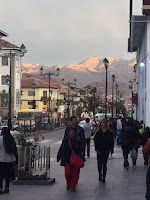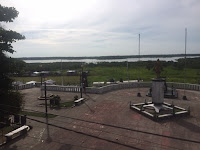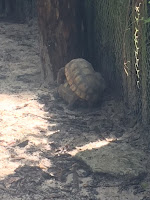The Wairau Valley Garden Tour has been and gone, and overall it was a great experience for me and Karyn. The 2 days preceding the tour were totally rained out – great for growing but hopeless for tidying up and weeding. Somehow, most of the important jobs were done and the kitchen garden has probably never looked so tidy, nor ever will again. Signs were put up around the garden explaining how things worked (e.g. keyhole beds, weed control, pest management, Solly) and there were lots of questions and good old garden discussions. I picked up a few tips, like using paper bags over grape bunches and thick newspaper to combat twitch grass. By far the commonest question related to pink-flowered strawberries, which I think may be the result of hybridisation of alpine strawberries with common strawberries. This is pure speculation, as I can’t really come up with any other explanation. Several people left happily with potted pink strawberry plants. Regrettably, I’d weeded that bed and surrounding path in the rain the day before and had relegated loads more to the compost heap.

 Despite being adamant about not undertaking another garden project this year, a new woodlot has made an appearance. It started with the 8 Manuka trees that I acquired at the ApiNZ conference, 6 of which were yet to be homed. Then I realised that 6 (of 7) oak trees that I’d grown in pots from acorns about 3 years ago had survived serious neglect/abandonment and were eager to grow bigger. Then it was Karyn’s birthday and she’d been wanting to plant a maple tree (to tap for maple syrup) for ages. A single mature-ish plant cost pretty much the same as a bulk lot of 10 very young trees, so instead of one, she got 10. Then there were the 3 peach trees, grown from peach stones, gifted to Karyn, and planted temporarily in her plot. That’s quite a list already, but luckily there’s a big section of the horse arena just sitting there being overgrown. Digging holes was a nightmare – having to penetrate established pasture weeds and several inches of hardcore. Each tree got a few spadesful of compost to keep them going until their roots get to the soil below the horse arena. In the end, there was space to also squeeze in 4 Eucalypts (Leucoxylon - winter flowering for bees), 4 Kanuka and a rogue pomegranate. And that was just one side of the section. The other side now contains 2 of the oaks, 3 hazelnuts, 2 sweet chestnuts, one almond and one walnut (seedling). Phew. Who needs a gym membership? This woodlot is much closer to the house than our previous attempt, so it’s in with a chance of being looked after. A hose is lined up to make irrigation really easy, and each tree has its own wool mulch mat pegged around its base. Dastardly weed killer has also been sprayed in places to reduce the massive weed load. Here’s hoping that some of these young trees make it to firewood.
Despite being adamant about not undertaking another garden project this year, a new woodlot has made an appearance. It started with the 8 Manuka trees that I acquired at the ApiNZ conference, 6 of which were yet to be homed. Then I realised that 6 (of 7) oak trees that I’d grown in pots from acorns about 3 years ago had survived serious neglect/abandonment and were eager to grow bigger. Then it was Karyn’s birthday and she’d been wanting to plant a maple tree (to tap for maple syrup) for ages. A single mature-ish plant cost pretty much the same as a bulk lot of 10 very young trees, so instead of one, she got 10. Then there were the 3 peach trees, grown from peach stones, gifted to Karyn, and planted temporarily in her plot. That’s quite a list already, but luckily there’s a big section of the horse arena just sitting there being overgrown. Digging holes was a nightmare – having to penetrate established pasture weeds and several inches of hardcore. Each tree got a few spadesful of compost to keep them going until their roots get to the soil below the horse arena. In the end, there was space to also squeeze in 4 Eucalypts (Leucoxylon - winter flowering for bees), 4 Kanuka and a rogue pomegranate. And that was just one side of the section. The other side now contains 2 of the oaks, 3 hazelnuts, 2 sweet chestnuts, one almond and one walnut (seedling). Phew. Who needs a gym membership? This woodlot is much closer to the house than our previous attempt, so it’s in with a chance of being looked after. A hose is lined up to make irrigation really easy, and each tree has its own wool mulch mat pegged around its base. Dastardly weed killer has also been sprayed in places to reduce the massive weed load. Here’s hoping that some of these young trees make it to firewood. Another project that has reached the top of the list is a deck. We’ve created a simple design that wraps around the back and side of the house so that each of the 3 ranch-sliders will open out onto decking. It gets rid of a great big chunk of lawn (no boys left at home to mow), and the flower bed at the back and the native bed at the side have been significantly widened/lengthened. There’ll be a single wide step down along the length of the far edge, wide enough to sit on, and gravelled paths that connect to the existing paths running along the edges of the deck and to the back gate. One tall post will eventually hold a corner of a shade sail. Peter’s ordered the wood and bought himself a mitre saw, and he's already got the first posts in. The photos show the weed mat paths and rocks that will border the planting beds. More hideous weed killer has been sprayed on the lawn that will be under the deck and paths. That was a really awful task - so sorry bees and other insects. Now I'm on the look-out for flowering and native plants to fill the expanded beds. Divisions of current plants will be possible once they've flowered, and there are 5 roses that will need to make their way over. Totally the wrong time of year to move them (I can hear you tutting Karyn) but it's hard to kill a rose eh?
Another project that has reached the top of the list is a deck. We’ve created a simple design that wraps around the back and side of the house so that each of the 3 ranch-sliders will open out onto decking. It gets rid of a great big chunk of lawn (no boys left at home to mow), and the flower bed at the back and the native bed at the side have been significantly widened/lengthened. There’ll be a single wide step down along the length of the far edge, wide enough to sit on, and gravelled paths that connect to the existing paths running along the edges of the deck and to the back gate. One tall post will eventually hold a corner of a shade sail. Peter’s ordered the wood and bought himself a mitre saw, and he's already got the first posts in. The photos show the weed mat paths and rocks that will border the planting beds. More hideous weed killer has been sprayed on the lawn that will be under the deck and paths. That was a really awful task - so sorry bees and other insects. Now I'm on the look-out for flowering and native plants to fill the expanded beds. Divisions of current plants will be possible once they've flowered, and there are 5 roses that will need to make their way over. Totally the wrong time of year to move them (I can hear you tutting Karyn) but it's hard to kill a rose eh?
 A gorgeous red rhododendron behind the pizza oven is flowering away, and another red rhodie next to the front door has just opened its first blossom. The colours in the garden are ridiculously cheery, from the deep blue of the ceanothus to the white Mexican orange blossom, and the bright red poppies. Paeonies are poised to burst any second now, and rosebuds are filling. The burgeoning lemonwood hedge is showing promise that it will eventually showcase the plants before it. The herbs are also flaunting themselves – bright pinky-purple rosemary flowers and heaps of fat sage buds, and chamomile and fennel popping up wherever it likes.
A gorgeous red rhododendron behind the pizza oven is flowering away, and another red rhodie next to the front door has just opened its first blossom. The colours in the garden are ridiculously cheery, from the deep blue of the ceanothus to the white Mexican orange blossom, and the bright red poppies. Paeonies are poised to burst any second now, and rosebuds are filling. The burgeoning lemonwood hedge is showing promise that it will eventually showcase the plants before it. The herbs are also flaunting themselves – bright pinky-purple rosemary flowers and heaps of fat sage buds, and chamomile and fennel popping up wherever it likes. Lots of veges are planted up, including spuds, though there’s still space for more. We’re not necessarily done with the frosty nights, so the likes of beans, snow peas and corn still need some protection. Cucumbers, peppers and tomatoes are being tended by Madame Cholet, and several other trays of seedlings are ready to be planted out. There’s plenty of spare pea straw that isn’t needed to re-mulch the vege garden – it’s gone down in the expanded native bed near the house. Weed control of the paths can be done with strong vinegar and Epsom salts now that all of them are young and small. The joys of having to get all your garden sorted out for a tour! Here’s hoping it works. An organic weed killer was recommended by a garden tour visitor that I may try out if not.
Lots of veges are planted up, including spuds, though there’s still space for more. We’re not necessarily done with the frosty nights, so the likes of beans, snow peas and corn still need some protection. Cucumbers, peppers and tomatoes are being tended by Madame Cholet, and several other trays of seedlings are ready to be planted out. There’s plenty of spare pea straw that isn’t needed to re-mulch the vege garden – it’s gone down in the expanded native bed near the house. Weed control of the paths can be done with strong vinegar and Epsom salts now that all of them are young and small. The joys of having to get all your garden sorted out for a tour! Here’s hoping it works. An organic weed killer was recommended by a garden tour visitor that I may try out if not. Sad plans are slowly being made to deal with the barren cattle and sheep. Peter’s looking at water buffalo (again) and we’ll probably get more ewes. The bees are busy, and Derryn has a split that I can have to replace the colony that died out in early spring. That’ll bring me up to 3 colonies again, plus enough hive ware for a 4th if a swarm presents. A quick decision to get pigs was made when we spotted some Wessex Saddleback (probably crosses) locally for sale. They were delivered the next day after a bit of sty and run preparation. As usual, Karyn got the naming rights. We rejected the bacon-themed names (Crispy?? Really???) and have settled instead on amazing wizards. Voldemort is totally black, Dumbledore has a wide saddle, and Snape a narrower saddle. They're 10-week old chunky critters and it's lovely to hear their dulcet tones as they go about trashing the run.
Sad plans are slowly being made to deal with the barren cattle and sheep. Peter’s looking at water buffalo (again) and we’ll probably get more ewes. The bees are busy, and Derryn has a split that I can have to replace the colony that died out in early spring. That’ll bring me up to 3 colonies again, plus enough hive ware for a 4th if a swarm presents. A quick decision to get pigs was made when we spotted some Wessex Saddleback (probably crosses) locally for sale. They were delivered the next day after a bit of sty and run preparation. As usual, Karyn got the naming rights. We rejected the bacon-themed names (Crispy?? Really???) and have settled instead on amazing wizards. Voldemort is totally black, Dumbledore has a wide saddle, and Snape a narrower saddle. They're 10-week old chunky critters and it's lovely to hear their dulcet tones as they go about trashing the run. Billy has left home once more, this time into the creature comforts of the delightful Lazy Mazy (who, unbelievably, he plans to re-name! Outrageous.) She’s now parked up at Outward Bound, awaiting a power source extension. He’ll be coming home on his days off, but otherwise will be stylishly accommodated in the caravan. Both Lucas and Sam (with Molly) came home for a weekend, so we were all together as a family again, if only briefly. Enough time, apparently, to be subjected to Monopoly, which Molly won resoundingly. Christmas requests and plans were made, and a shocking realisation that the Christmas cake didn't exist yet. Usually, it's baked around Easter and packed full of brandy. The ingredients were duly rounded up and this year's cake is indulgently marinading in a decent volume of brandy, awaiting its decoration with marzipan and icing in the theme of 'China'. The request is for a traditional turkey dinner this year, which hasn't been done since our first NZ Christmas when it was 28 degrees and no-one was hungry. After 13 years maybe it's worth another try, if only for nostalgia. We're really looking forward to a visit from Auntie Sally in early/mid-December, so starting to think about what activities we can line up for her. Hmmm, maybe egg-roulette??
Billy has left home once more, this time into the creature comforts of the delightful Lazy Mazy (who, unbelievably, he plans to re-name! Outrageous.) She’s now parked up at Outward Bound, awaiting a power source extension. He’ll be coming home on his days off, but otherwise will be stylishly accommodated in the caravan. Both Lucas and Sam (with Molly) came home for a weekend, so we were all together as a family again, if only briefly. Enough time, apparently, to be subjected to Monopoly, which Molly won resoundingly. Christmas requests and plans were made, and a shocking realisation that the Christmas cake didn't exist yet. Usually, it's baked around Easter and packed full of brandy. The ingredients were duly rounded up and this year's cake is indulgently marinading in a decent volume of brandy, awaiting its decoration with marzipan and icing in the theme of 'China'. The request is for a traditional turkey dinner this year, which hasn't been done since our first NZ Christmas when it was 28 degrees and no-one was hungry. After 13 years maybe it's worth another try, if only for nostalgia. We're really looking forward to a visit from Auntie Sally in early/mid-December, so starting to think about what activities we can line up for her. Hmmm, maybe egg-roulette??
We're still on alert for a final frost (known here as the Muller Frost - named after the bloke who noticed that there was always one more frost after you were sure they were over), but otherwise are contentedly adjusting to the balmier temperatures of spring. It's a truly beautiful time of year to be living so close to nature, a blessing indeed.







































































